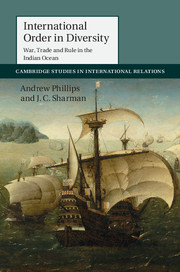Book contents
- Frontmatter
- Contents
- List of maps
- List of tables
- Acknowledgements
- Introduction
- 1 The puzzle of durable diversity in International Relations
- 2 The initial growth of diversity, 1500–1600
- 3 The expansion of diversity and competition under heteronomy, 1600–1650
- 4 The stabilization of diversity, 1600–1750
- 5 Reconfiguring diversity in the age of empire, 1750–1900
- Conclusion: Order in diversity
- Bibliography
- Index
- CAMBRIDGE STUDIES IN INTERNATIONAL RELATIONS
5 - Reconfiguring diversity in the age of empire, 1750–1900
Published online by Cambridge University Press: 05 May 2015
- Frontmatter
- Contents
- List of maps
- List of tables
- Acknowledgements
- Introduction
- 1 The puzzle of durable diversity in International Relations
- 2 The initial growth of diversity, 1500–1600
- 3 The expansion of diversity and competition under heteronomy, 1600–1650
- 4 The stabilization of diversity, 1600–1750
- 5 Reconfiguring diversity in the age of empire, 1750–1900
- Conclusion: Order in diversity
- Bibliography
- Index
- CAMBRIDGE STUDIES IN INTERNATIONAL RELATIONS
Summary
Durable diversity in the early modern Indian Ocean rested on three factors: contrasting but compatible preferences between Europeans and local polities, distinct but equivalent beliefs concerning heteronomous authority, and improvised practices of localization. As much as this argument stands alone, it is important to establish that after 1750 we do not see the unfolding of a familiar conventional story of interaction driving convergence on the sovereign state model, thus replicating the European experience, albeit with a 250-year lag. Instead, this chapter advances two crucial interlinked points that illustrate the Indian Ocean's continuing distinctiveness, and the danger of basing International Relations theory on the presumed universality of the European experience. First, rather than being abolished, the region's existing diversity of suzerain, galactic and vassal arrangements was incorporated within new, Western-dominated hybrid imperial frameworks after 1750. Second, whereas in Europe the international system evolved from heteronomy towards an anarchical system of sovereign states, in the Indian Ocean right down to the post-World War II era, the progression was from heteronomy to imperial hierarchy. Globally, the European sovereign state system therefore remained the exception rather than the rule right down to the second half of the twentieth century.
By 1849, despite lacking any decisive technological military advantages over its local rivals, the English East India Company had conquered a population of over 150 million people on the Indian subcontinent. Beyond India, the company had also wrested control of the Cape Colony, Ceylon and Dutch settlements in the Indonesian archipelago from the Batavian Republic (the VOC having by then gone bankrupt) and had also subjected central Java's feuding sultanates to direct European rule for the first time. While London transferred the sovereignty of Dutch possessions in Indonesia to the newly formed United Kingdom of the Netherlands after 1815, the British Raj there-after spread throughout the Indian Ocean, a web of suzerain linkages tying polities in East Africa, the Persian Gulf and South-East Asia to the empire's subcontinental core.
- Type
- Chapter
- Information
- International Order in DiversityWar, Trade and Rule in the Indian Ocean, pp. 166 - 201Publisher: Cambridge University PressPrint publication year: 2015

